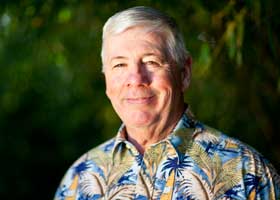"Treatment of chronic wounds takes persistence, hope and sometimes a little teamwork"

For most of us, having a wound means cleaning it, maybe applying some ointment and putting on a bandage. A few days later, poof! It’s healed.
Others who are living with diabetes or vascular conditions are not so fortunate. Just ask Sean Dougherty, 66, of Monroe Township. Before his wound was healed, Sean spent more than 20 years as one of an estimated 6.5 million people living with chronic wounds in the United States.
A Long History
Sean’s story begins in 1980, when he was a healthy young man of 33 taking his dog for a walk. Out of breath after just a few steps, Sean knew something was not right. After some testing, it was determined Sean had thrombophlebitis and a blood clot was causing his oxygen levels to drop and his legs to swell.
Ten years later, Sean continued to have swelling in his legs as a result of post-phlebitic syndrome. When combined with valve damage in his deep venous system from the blood clot, Sean’s post-phlebitic syndrome caused skin problems resulting in an ulcer, or wound, on his calf.
That was in the early 1990s. For more than two decades, Sean has been battling a wound that just wouldn’t go away.
“It would get infected, then subside, then reinfect. It never really healed,” explains Sean.
The ‘Dream Team’
When the wound care center Sean was visiting for care announced it was closing, Sean was referred to RWJ Hamilton’s Center for Wound Healing.
“When he arrived here, our first steps were to take a culture, photograph the wound and measure it. Sean tested positive for MRSA, which was unidentified to that point,” explains Reza Shah, DO, board certified general surgeon with a fellowship in vascular surgery, co-medical director of the Center for Wound Healing.
MRSA is an antibiotic-resistant bacteria with a high risk for complications, including death. Dr. Shah called on Patrick Aufiero, MD, board certified in infectious disease, to determine the course of treatment needed to help Sean’s stubborn wound.
“We applied a bioengineered skin substitutes and tried Sean’s own skin complemented by hyperbaric oxygen therapy treatments. We were chasing our tails because the leg ulcer continued to get reinfected,” Dr. Shah says.
Sean spent so much time in the wound care center, he would often joke that he should be receiving an employee discount in the hospital’s café. Time and again, the wound would persist.
Finally, Drs. Shah and Aufiero determined the key to healing Sean’s wound was to take him off of his feet for a long period of time. Sean cleared his calendar and was admitted to the hospital.
“That was really tough because I didn’t feel physically sick. But they knew how to win this war. They just needed my help to stop everything for a while so they could take care of this situation,” recalls Sean.
Sean received IV antibiotics for 31 days in the hospital. He was instructed to stay off of his feet and to keep his leg elevated. “Ultimately, that is what worked,” says Dr. Shah.
‘I’m a Miracle’
After his leg finally healed, Sean had one goal. “I wanted to go swimming. My wife and I booked a trip to St. Lucia and I got into a swimming pool for the first time in decades,” he says.
These days Sean is back to being his active self. His business and family keep him busy and he’s happy he can participate in his life again.
“I would have to change dressings often, sometimes two and three times a day. I always wore black pants. Now I’m losing weight. I don’t have pain. I feel like I’m a miracle.”
Dr. Shah agrees it was quite a feat healing Sean’s wound. But most importantly, he says, the experience restored Sean’s hope.
“It was truly a team effort by our entire staff to help Sean. He is an avid traveler and owns a travel business. Having this wound for more than 20 years prevented him from doing so much. Healing it has changed his life,” says Dr. Shah.